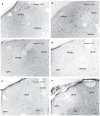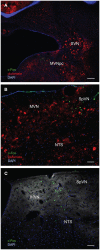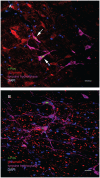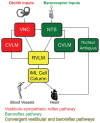Fos expression in neurons of the rat vestibulo-autonomic pathway activated by sinusoidal galvanic vestibular stimulation
- PMID: 22403566
- PMCID: PMC3289126
- DOI: 10.3389/fneur.2012.00004
Fos expression in neurons of the rat vestibulo-autonomic pathway activated by sinusoidal galvanic vestibular stimulation
Abstract
The vestibular system sends projections to brainstem autonomic nuclei that modulate heart rate and blood pressure in response to changes in head and body position with regard to gravity. Consistent with this, binaural sinusoidally modulated galvanic vestibular stimulation (sGVS) in humans causes vasoconstriction in the legs, while low frequency (0.02-0.04 Hz) sGVS causes a rapid drop in heart rate and blood pressure in anesthetized rats. We have hypothesized that these responses occur through activation of vestibulo-sympathetic pathways. In the present study, c-Fos protein expression was examined in neurons of the vestibular nuclei and rostral ventrolateral medullary region (RVLM) that were activated by low frequency sGVS. We found c-Fos-labeled neurons in the spinal, medial, and superior vestibular nuclei (SpVN, MVN, and SVN, respectively) and the parasolitary nucleus. The highest density of c-Fos-positive vestibular nuclear neurons was observed in MVN, where immunolabeled cells were present throughout the rostro-caudal extent of the nucleus. c-Fos expression was concentrated in the parvocellular region and largely absent from magnocellular MVN. c-Fos-labeled cells were scattered throughout caudal SpVN, and the immunostained neurons in SVN were restricted to a discrete wedge-shaped area immediately lateral to the IVth ventricle. Immunofluorescence localization of c-Fos and glutamate revealed that approximately one third of the c-Fos-labeled vestibular neurons showed intense glutamate-like immunofluorescence, far in excess of the stain reflecting the metabolic pool of cytoplasmic glutamate. In the RVLM, which receives a direct projection from the vestibular nuclei and sends efferents to preganglionic sympathetic neurons in the spinal cord, we observed an approximately threefold increase in c-Fos labeling in the sGVS-activated rats. We conclude that localization of c-Fos protein following sGVS is a reliable marker for sGVS-activated neurons of the vestibulo-sympathetic pathway.
Keywords: blood pressure; heart rate; orthostatic hypotension; otolith organs; rostral ventrolateral medulla; sympathetic nervous system; vasovagal syncope; vestibular nuclei.
Figures









Similar articles
-
Projection neurons of the vestibulo-sympathetic reflex pathway.J Comp Neurol. 2014 Jun 15;522(9):2053-74. doi: 10.1002/cne.23517. J Comp Neurol. 2014. PMID: 24323841 Free PMC article.
-
Imidazoleacetic acid-ribotide in vestibulo-sympathetic pathway neurons.Exp Brain Res. 2016 Oct;234(10):2747-60. doi: 10.1007/s00221-016-4725-2. Epub 2016 Jul 13. Exp Brain Res. 2016. PMID: 27411812 Free PMC article.
-
Glutamate and GABA in Vestibulo-Sympathetic Pathway Neurons.Front Neuroanat. 2016 Feb 8;10:7. doi: 10.3389/fnana.2016.00007. eCollection 2016. Front Neuroanat. 2016. PMID: 26903817 Free PMC article.
-
Organization of vestibular nucleus projections to the caudal dorsal cap of kooy in rabbits.Neuroscience. 1994 Oct;62(4):1217-36. doi: 10.1016/0306-4522(94)90354-9. Neuroscience. 1994. PMID: 7845595 Review.
-
Organization of the coeruleo-vestibular pathway in rats, rabbits, and monkeys.Brain Res Brain Res Rev. 1999 Aug;30(2):189-217. doi: 10.1016/s0165-0173(99)00015-6. Brain Res Brain Res Rev. 1999. PMID: 10525175 Review.
Cited by
-
An Experimental Model of Vasovagal Syncope Induces Cerebral Hypoperfusion and Fainting-Like Behavior in Awake Rats.PLoS One. 2016 Sep 22;11(9):e0163280. doi: 10.1371/journal.pone.0163280. eCollection 2016. PLoS One. 2016. PMID: 27658057 Free PMC article.
-
The vasovagal response of the rat: its relation to the vestibulosympathetic reflex and to Mayer waves.FASEB J. 2013 Jul;27(7):2564-72. doi: 10.1096/fj.12-226381. Epub 2013 Mar 15. FASEB J. 2013. PMID: 23504712 Free PMC article.
-
Pulsed Infrared Stimulation of Vertical Semicircular Canals Evokes Cardiovascular Changes in the Rat.Front Neurol. 2021 May 28;12:680044. doi: 10.3389/fneur.2021.680044. eCollection 2021. Front Neurol. 2021. PMID: 34122320 Free PMC article.
-
What galvanic vestibular stimulation actually activates.Front Neurol. 2012 Jul 20;3:117. doi: 10.3389/fneur.2012.00117. eCollection 2012. Front Neurol. 2012. PMID: 22833733 Free PMC article.
-
Headache and Autonomic Dysfunction: a Review.Curr Neurol Neurosci Rep. 2022 Oct;22(10):625-634. doi: 10.1007/s11910-022-01225-3. Epub 2022 Aug 22. Curr Neurol Neurosci Rep. 2022. PMID: 35994191 Review.
References
-
- Armstrong D. M., Ross C. A., Pickel V. M., Joh T. H., Reis D. J. (1982). Distribution of dopamine-, noradrenaline-, and adrenaline-containing cell bodies in the rat medulla oblongata: Demonstration by the immunocytochemical localization of catecholamine biosynthetic enzymes. J. Comp. Neurol. 212, 173–18710.1002/cne.902120207 - DOI - PubMed
Grants and funding
LinkOut - more resources
Full Text Sources
Medical

